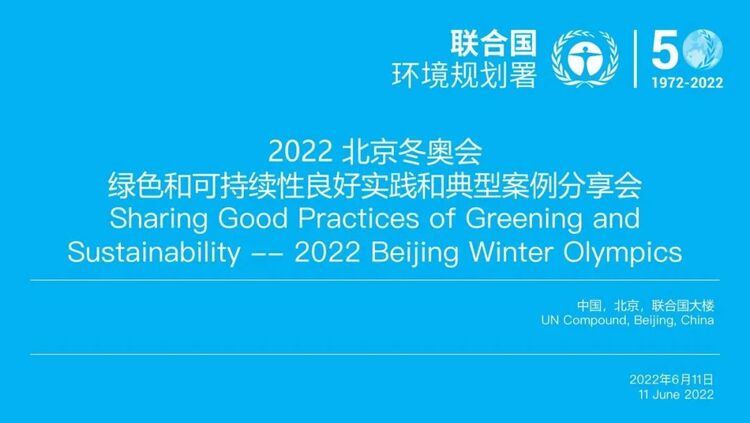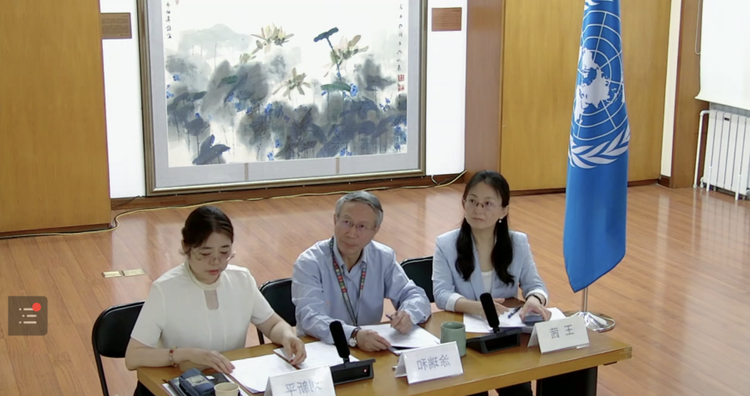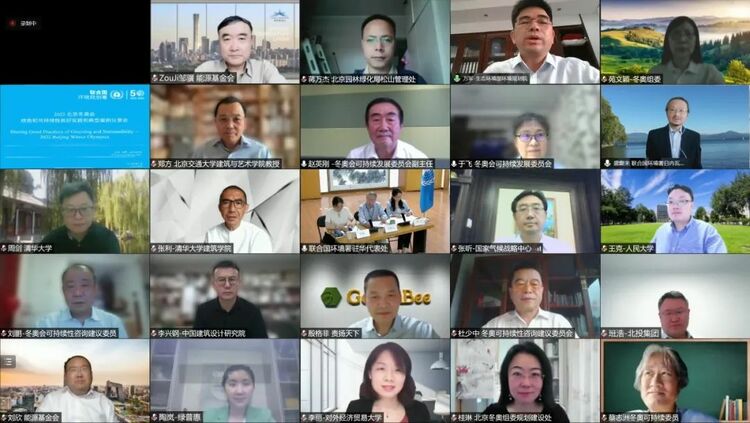
Recently, "Sharing Good Practices of Greening and Sustainability — 2022 Beijing Winter Olympics", hosted by the United Nations Environment Program (UNEP) China Office, was held at the UN Compound in Beijing, China, both online and offline.
Outstanding representatives including the relevant people in charge of the Beijing Organizing Committee for the 2022 Olympic and Paralympic Winter Games (BOCOG), members and experts of the Beijing 2022 Sustainability Advisory Committee, competition zone and venue designers, and core teams, focusing on three themes, namely sustainable management, ecological & environmental protection, and carbon neutrality, shared splendid stories about how the concepts of "green Winter Olympics" and "sustainability" were implemented in the pre-games planning, the planning and design of the venues and facilities in the three competition zones, in the construction period, during and after the Games.

Tu Ruihe, Representative of the UNEP China Office, noted in his speech that he was honored to be invited to serve as a member of the Beijing 2022 Sustainability Advisory Committee, and have the opportunity to participate in the work related to sustainability of the Beijing Olympic Winter Games. He also shared the relevant concepts of the Sustainable Infrastructure Partnership and the International Good Practice Principles for Sustainable Infrastructure, led by the UNEP.
In 2022, the Beijing Winter Olympics came to a successful conclusion, fully implementing the concepts of "green, inclusive, open and clean" Games, the sustainability vision of "Sustainability for the Future", and various principles of sustainability. On June 5, 2022, the World Environment Day, the International Olympic Committee released a report, praising the efforts and attempts of the Beijing 2022 in the areas of low-carbon & sustainable development and environmental protection, such as "creativity", "100% new energy", "building venues surrounded by mountains and forests", "eco-friendly Olympics", "Chinese romance" and "Chinese wisdom". All these highlight the contributions of the Beijing Winter Olympics to the realization of the UN Sustainable Development Goals (SDGs) to be achieved by 2030.

Session 1
The Sustainability of the Beijing Winter Olympics
Session 1, moderated by Tu Ruihe, focused on the sustainable strategy and implementation of the Beijing Olympic Winter Games.
Liu Xinping, Director of the Sustainable Development Division of the Beijing 2022 General Planning Department, introduced the sustainability plan, implementation and impact of the Games. "The Beijing 2022 is the first Olympic Games to fully implement the sustainability requirements of the Olympic Agenda 2020 from preparation to delivery. Sustainability requirements were integrated into the daily operation and management of the whole process covering the preparation, staging, planning and implementation of the Beijing Olympic Winter Games, and it is the first Olympic Games to achieve carbon neutrality."
Li Li, Associate Researcher of the Academy of China Open Economy Studies and Beijing Open Economy Research Institute, University of International Business and Economics, shared the role and impact of the sustainability management system of the Beijing Winter Olympics in the context of challenges, solutions and achievements. Liu Peng, Chief Engineer of China Architecture Design & Research Institute (CADRI), shared the impact of sustainability in the construction of Yanqing District venues. Taking sustainability as a prerequisite principle and requirement, planning and management before engineering design and construction are the key to integrating the sustainability principle into practice. Yanqing Competition Zone has achieved the goal of using 100% renewable energy, successfully protected more than 80,000 m³ of topsoil rich in precious seed resources with topsoil stripping technology in the construction process, and cultivated construction management teams with sustainable construction capacity.
Du Shaozhong, Vice President of the All-China Environment Federation, Yu Fei, Former Inspector of the Department of Atmospheric Environment, the Ministry of Ecology and Environment (MEE), and Zhao Yinggang, Former Director of the Winter Sports Administration Center of the General Administration of Sport of China, commented on the sustainability work of the Beijing Winter Olympics. The sustainability work of the Beijing Winter Olympics starting from the top design has set up a complete set of large-scale sports event management system and work mechanism including the large-scale sports event sustainability evaluation guidelines which have entered the international ISO standard application process. This has laid a solid foundation for the sustainability work of the Beijing Winter Olympics and is a typical example of implementing carbon emission reduction and climate change mitigation goals. The important achievement of sustainability management is training a group of sustainability management personnel of the Winter Olympics and raising the awareness of sustainable development across the whole society.
Session 2
Ecological and Environmental Protection of the Beijing Winter Olympics
Session 2 was moderated by Wang Qian, Program Management Officer of the UNEP China Office.
Li Xinggang, Chief Architect of CADRI and Chief Designer of Yanqing Competition Zone of the Beijing Winter Olympics, shared concepts, practices and innovative application technologies of economic, social and environmental sustainable design in Yanqing Competition Zone. He noted that at the beginning of the planning and design of Yanqing Competition Zone, the planning and design concept of "building venues surrounded by mountains and forests and hosting an eco-friendly Winter Olympics" was put forward, and this concept was implemented from the beginning of planning and design to the whole process of construction and operation of the project. At the National Alpine Skiing Center in Yanqing Competition Zone, for example, a mountain aerial platform system featuring "weak intervention, reversible functional type, and assembly structural style" draws inspiration from the traditional wisdom of building residences in mountainous regions, minimizes intervention and damage construction causes to the mountainous environment and biodiversity, and presents an eco-sensitive case of green Olympic Games, which features intensive venue building in complicated mountainous environment.
Zheng Fang, Principal Architect of National Speed Skating Oval known as the "Ice Ribbon" and the National Aquatics Center dubbed as the "Ice Cube", shared how to achieve sustainable operation and small environmental impact of sports venues from the perspective of design, taking the transformation of the Ice Cube and the newly built Ice Ribbon as examples. He noted that the use of light-weight prefabricated venue structures, equipment and new intelligent systems has enabled the expansion of all-new functions based on an existing "Water Cube" swimming venue, which can be maintained for a long time after the Games. The design inspiration for building the Ice Ribbon, namely "turning a smaller refrigerator into a very intensive venue space", showcases the process of shaping architectural design and aesthetics with sustainability, which significantly improves resource and energy efficiency.
Zhang Li, Chief Planner of Zhangjiakou Competition Zone and Chief Designer of Big Air Shougang, shared the sustainable practice of Zhangjiakou Competition Zone from the perspective of the UN SDGs. He noted that the sustainable design of the Beijing Winter Olympics reinterprets the traditional understanding of nature and traditional wisdom of Chinese people. The "minimal natural footprint" has been achieved in the construction of the new venues in Zhangjiakou Competition Zone through local and respectful mountain surface protection and ecological restoration technologies.
Wan Jun, Chief Engineer of the Chinese Academy of Environmental Planning, MEE, Sheng Fulai, Senior Environmental Economist of UNEP Geneva, and Cai Zhizhou, Chief Engineer of the Environmental Protection Center, the Ministry of Transport, commented on the ecological and environmental protection practices of the Beijing Winter Olympics. The sustainability work of the Beijing Olympic Winter Games has contributed a green and low-carbon Winter Olympic model to the world, as well as a classic case for the realization of the goal of building a beautiful China. We need to further think about how to replicate the green and low-carbon transformation experience of the Winter Olympic venues to other places at home and abroad. The local protection and transplanting measures of ecosystem and biodiversity adopted in the two mountainous competition zones have well protected the animals, plants and ecological environment under provincial or national key protection, such as Himalayan Gorals, Siberian roe deer, eagles and Batrachium pekinense.
The sustainable planning and design of the venues in the three competition zones of the Beijing Winter Olympics is a good practice of social, economic and environmental sustainability in cities and surrounding eco-sensitive areas. The design and construction of the competition venues not only combine China's traditional wisdom of harmonious coexistence and sci-tech innovation, but also make beneficial explorations centered on the concept of global sustainable development, contributing Chinese solutions and wisdom to the building of sustainable sports facilities, and interpreting how the sustainable sports infrastructure can truly be environmentally, socially, economically friendly, development-friendly and games-friendly.
Session 3
Carbon Neutrality of the Beijing Winter Olympics
Session 3 was moderated by Liu Xinping, Director of the Sustainable Development Division of the Beijing 2022 General Planning Department.
Zhou Jian, Professor at the Institute of Energy, Environment and Economy, Tsinghua University, reviewed the whole process of low-carbon management planning and implementation of the Winter Olympics covering application, preparation and hosting since 2015, especially the methodology of carbon accounting and carbon offsetting. Ban Hao, Project Manager of Temporary Facilities for the Winter Olympics, Beijing Investment Group, shared sustainable cases of temporary facilities for Olympic venues from design, construction, demolition and restoration to post-Games utilization. Gui Lin, Planning Director of the Planning and Construction Department of BOCOG, shared the pioneering use of carbon dioxide refrigeration technology in the ice sports venues of the Beijing Winter Olympics. The ice surface made with carbon dioxide refrigeration technology has no bubbles or cracks, creating a hardware case of the world's "fastest ice" in the "Ice Ribbon".
Zou Ji, President of Energy Foundation China, Zhang Xin, Chief Economist of the National Center for Climate Change Strategy and International Cooperation, and Wang Ke, Professor at the School of Environment and Natural Resources, Renmin University of China (RUC), and Researcher at the National Academy of Development and Strategy, RUC, commented on the carbon-neutral management of the Beijing Winter Olympics. The demonstration of the Beijing Winter Olympics is an advanced practice of carbon neutrality on a global scale. The overall technical specification process and related standards of greenhouse gas emission accounting, verification and recognition established by the Beijing Winter Olympics constitute a replicable and popularizable Chinese standard system for hosting the low-carbon Olympics. In the urban area of Beijing, Yanqing and Zhangjiakou, the renewable energy system has been deployed at a large spatial scale, including the demonstration project of the Zhangbei flexible direct current power grid, proving that regional innovation has great potential in optimizing the allocation of green and low-carbon resources.
Green, low-carbon and sustainable management is a prominent feature of the Beijing Winter Olympics. The traditional Chinese concept of harmonious coexistence between man and nature, and the concept of green and low-carbon development, are closely integrated with sustainable development. Exploration has resulted in new ideas, new technologies and new standards, which are in line with the domestic and international concept of sustainable development, and the extension of the Olympic spirit. All these remarkably reflect the principles of peace, solidarity, equity, inclusiveness, non-discrimination, sustainable development and prosperity advocated and upheld by the UN.